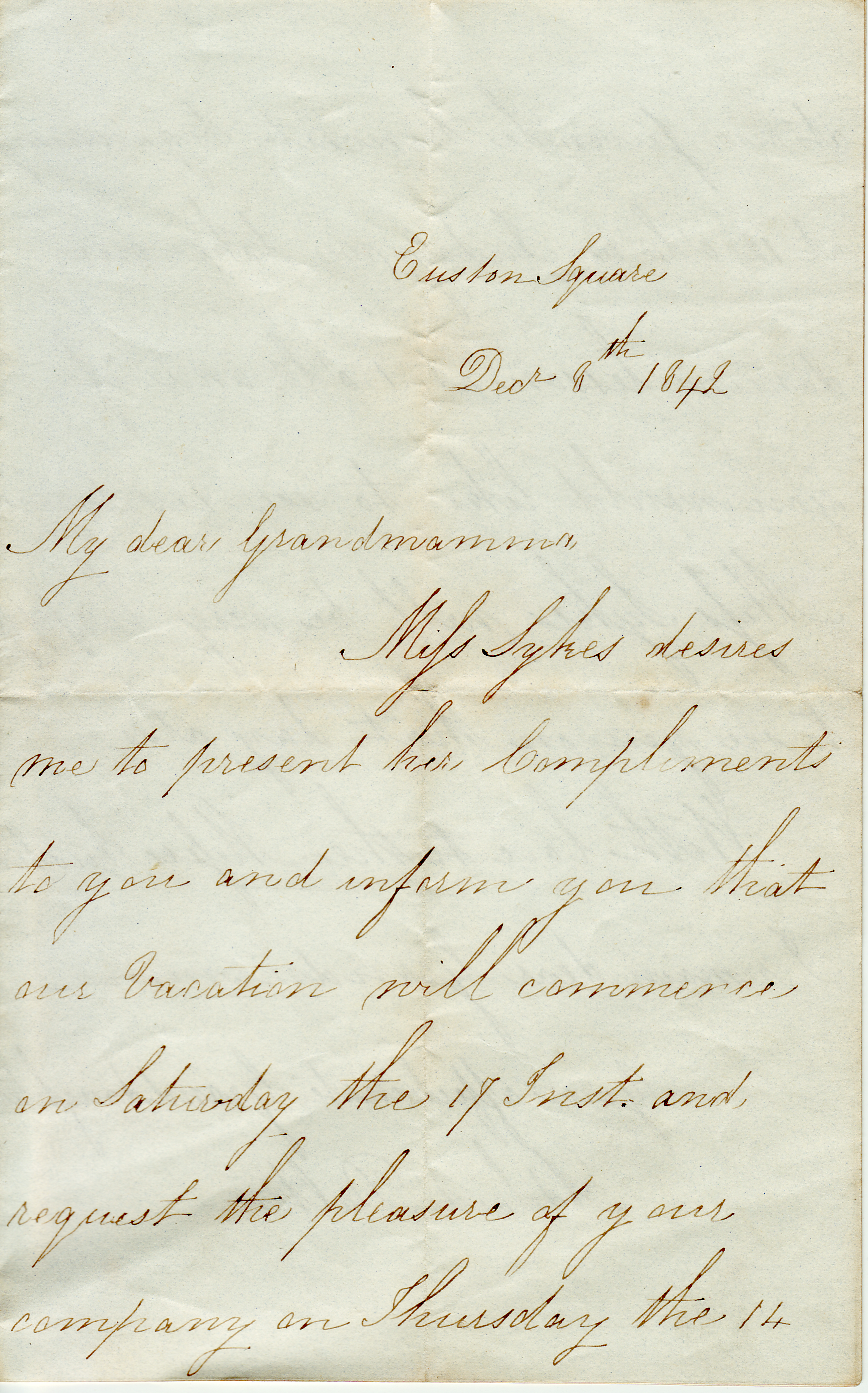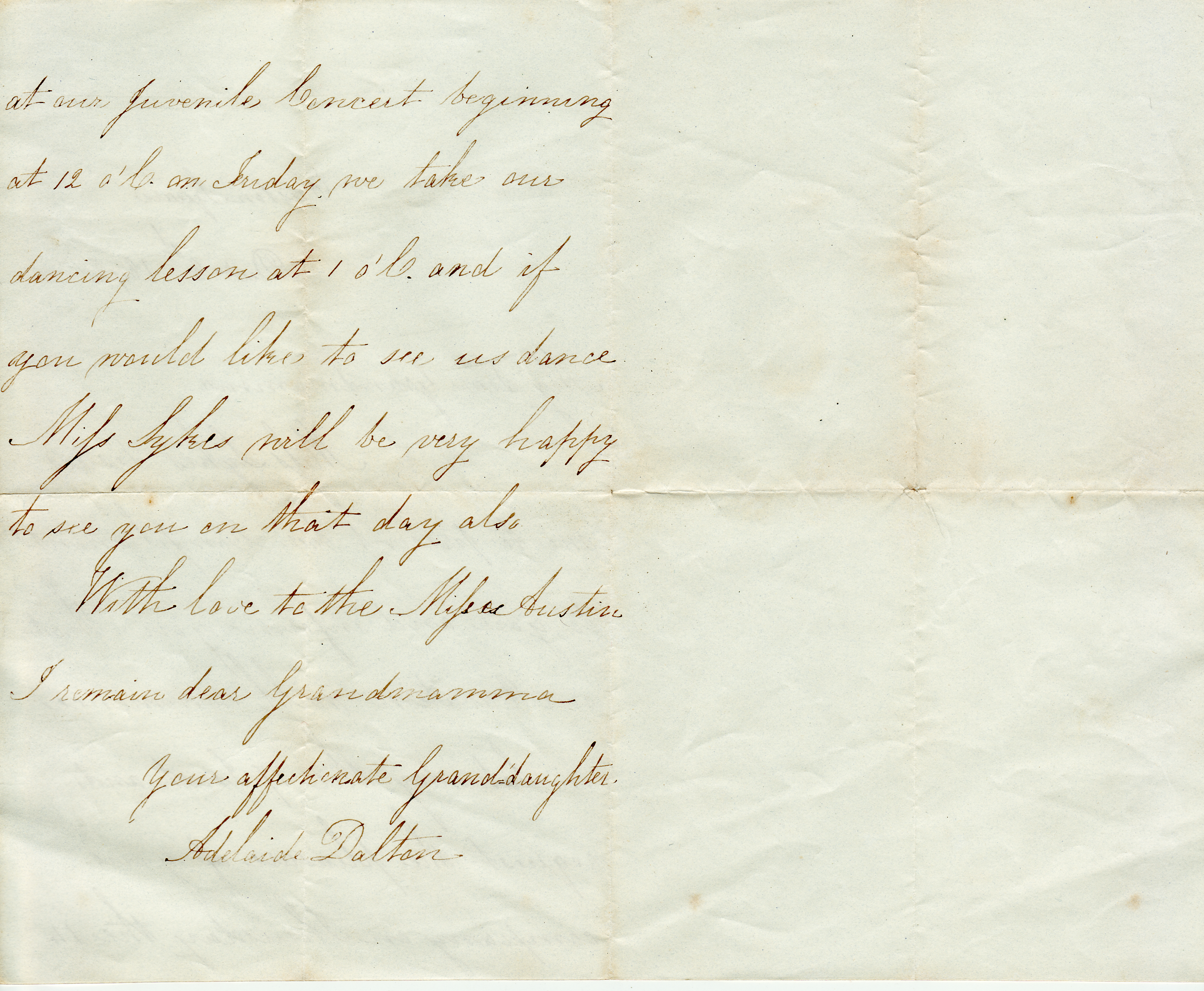 11 year old Adelaide Dalton wrote to her grandmother, Elizabeth Guest on December 8th 1842.
11 year old Adelaide Dalton wrote to her grandmother, Elizabeth Guest on December 8th 1842.
Adelaide Maria Dalton was born in 1831 in Watford, Hertfordshire, the child of Christopher and Elizabeth Maria. She was married in October 1849 in Watford, Hertfordshire. She died on April 18, 1869, in Surrey, at the age of 38, and was buried in Swindon, Gloucestershire.
Euston Square
Decᵣ 8ᵗʰ 1842
My dear Grandmamma,
Miss Sykes desires me to present her compliments to you and inform you that our vacation will commence on Saturday the 17ᵗʰ inst. and request the pleasure of your company on Thursday the 14ᵗʰ at our juvenile concert beginning at 12 o’clock.
On Friday we take our dancing lesson at 1 o’clock, and if you would like to see us dance Miss Sykes will be very happy to see you on that day also.
With love to the Misses Austin,
I remain dear Grandmamma,
Your affectionate granddaughter,
Adelaide Dalton.
Line-by-Line Explanation:
 1. “Euston Square, Decᵣ 8ᵗʰ 1842”
1. “Euston Square, Decᵣ 8ᵗʰ 1842”
-
Euston Square: A respectable address in London at the time, suggesting Adelaide was attending a school or seminary for girls there—likely one for the well-to-do.
-
Decᵣ is a common 19th-century abbreviation for “December.”
-
The date tells us this was written in the early Victorian period, during the reign of Queen Victoria (who came to the throne in 1837).
2. “My dear Grandmamma,”
-
Warm, respectful address. The use of “Grandmamma” reflects both affection and formality typical of well-brought-up Victorian children.
3. “Miss Sykes desires me to present her compliments to you…”
-
Miss Sykes is likely Adelaide’s headmistress or a teacher.
-
The phrase “present her compliments” was a polite social form of sending greetings or regards, often from a superior or host.
4. “…and inform you that our vacation will commence on Saturday the 17ᵗʰ inst.”
-
“Inst.” is short for instante mense, Latin for “of the current month.”
-
She’s letting her grandmother know when the school holidays will begin (Saturday the 17th of December).
5. “…and request the pleasure of your company on Thursday the 14ᵗʰ at our juvenile concert beginning at 12 o’clock.”
-
Adelaide extends an invitation to a school concert (likely music or performance by pupils) before the term ends.
-
Juvenile concert means the performance was by children.
-
Noon concerts were fashionable events in female academies of the time, used to showcase the refinement and accomplishments of pupils to their families.
6. “On Friday we take our dancing lesson at 1 o’clock…”
-
Formal dance training was a key part of a girl’s education, reflecting good breeding.
-
Dance lessons often included the quadrille, waltz, or polite country dances popular at Victorian social events.
7. “…and if you would like to see us dance Miss Sykes will be very happy to see you on that day also.”
-
The grandmother is welcome to attend the dancing lesson too—possibly a performance element, or simply a chance to see the girls’ progress.
-
This also shows how student accomplishments were demonstrated to family members before holidays—reinforcing the value of the schooling they were paying for.
8. “With love to the Misses Austin…”
-
Indicates affection for other family members or acquaintances—“the Misses Austin” were likely relatives or family friends, possibly cousins.
-
Multiple women with the surname Austin who shared a household or family.
9. “I remain dear Grandmamma, Your affectionate granddaughter, Adelaide Dalton.”
-
A formal and affectionate sign-off, typical of Victorian correspondence.
-
“I remain” shows a sustained relationship, often used in letters to maintain continuity of affection and politeness.
Social and Historical Context
Education:
-
Adelaide appears to be at a ladies’ seminary—a private school where girls from middle- and upper-class families learned music, dancing, French, penmanship, and etiquette, in addition to basic academics.
-
These accomplishments were vital for young women’s social mobility and marriage prospects.
Family Structure:
-
The letter reflects a close relationship with her grandmother, a common figure in the upbringing of children in well-off Victorian families.
-
Letters like this helped maintain bonds when children were away at boarding school.
Letter-writing etiquette:
-
Carefully composed, beautifully written letters were expected of young ladies.
-
The tone is deferential, polite, and affectionate—model Victorian traits.
Summary
This letter from Adelaide Dalton, written at age perhaps 10–14, is a charming snapshot of a genteel girl’s life in 1842. It reflects:
-
The formal tone of education and correspondence in upper/middle-class Victorian society.
-
An emphasis on music and dance as key accomplishments for girls.
-
Social rituals like concerts and dancing demonstrations at school.
-
Warm intergenerational family ties, especially between grandchildren and grandparents.
1. Location in Central London
Euston Square is situated in central London, near Bloomsbury and Regent’s Park—areas historically associated with education, medicine, and the upper middle class. In the early 19th century, this part of London was developed with elegant Georgian and early Victorian houses, aimed at professional and genteel families.
2. Architectural and Urban Development
-
Euston Square was developed in the 1820s and 1830s as part of the urban expansion driven by the opening of Euston Station (opened 1837).
-
The houses around the square were townhouses built for doctors, lawyers, civil servants, and educators—not the elite aristocracy, but certainly respectable middle-to-upper-middle class.
-
It was part of a carefully planned area—clean, orderly, and far removed from the industrial grime or slums of other districts.
3. Historical References
Writers and sources from the 19th century confirm its reputation:
-
Charles Dickens, in several of his works and letters, refers to the area near Euston as quiet, respectable, and middle-class.
-
Victorian directories and censuses list many governesses, scholars, physicians, and retired military officers living in and around Euston Square.
4. Association with Education and Seminars
-
By the 1840s, this area hosted several private academies and ladies’ seminaries, such as the one Adelaide likely attended.
-
These institutions catered to the daughters of well-off families, reinforcing the square’s association with respectability and refinement.
5. Map and Rate Book Evidence
-
London rate books (records of property values and taxes) show that properties in Euston Square were highly rated, meaning the tenants had to be of financial means.
-
Victorian maps and property listings show that these were well-appointed, multi-storey townhomes, often rented to or owned by people of social standing.
Summary
So, when Adelaide writes from Euston Square in 1842, she’s writing from:
-
A planned residential square in a desirable part of London.
-
An area known for its cleanliness, quiet respectability, and proximity to cultural and educational institutions.
-
A district commonly home to middle- to upper-middle class professionals, especially educators and civil servants.
It’s not Mayfair or Belgravia—but in Victorian terms, it was definitely respectable and aspirational.
